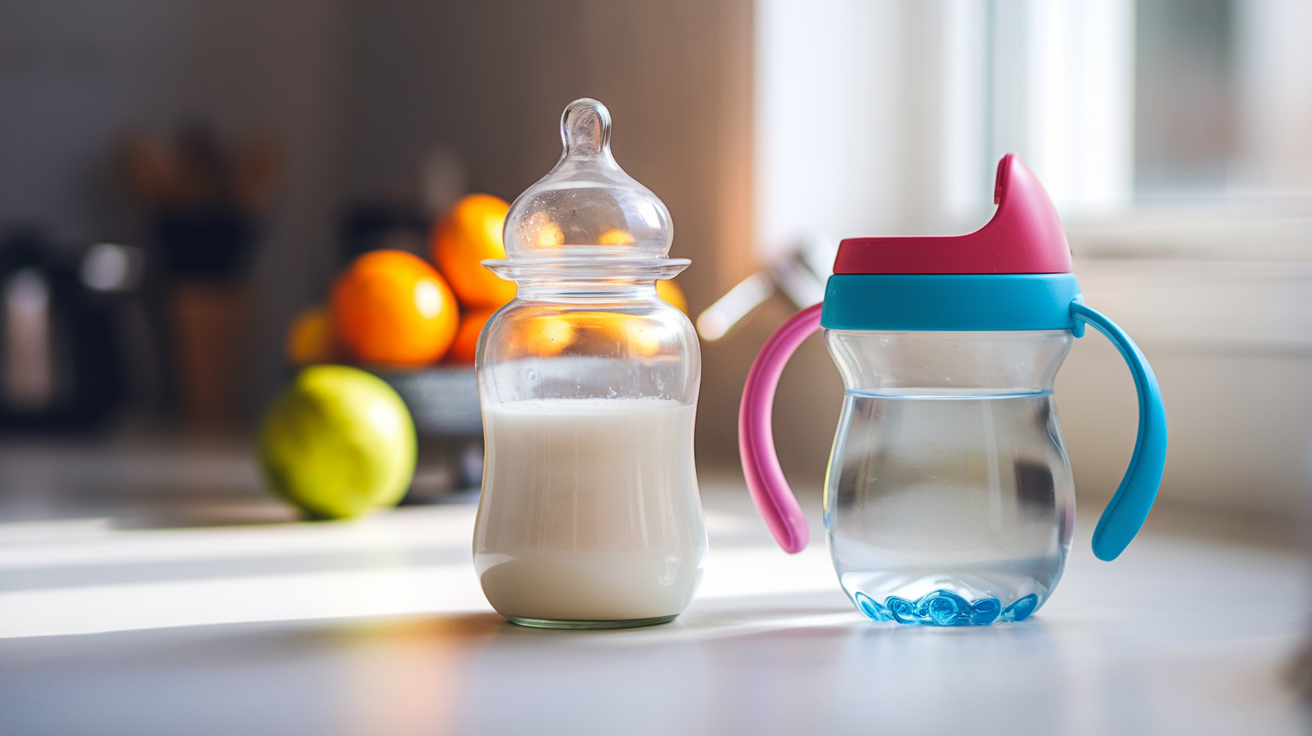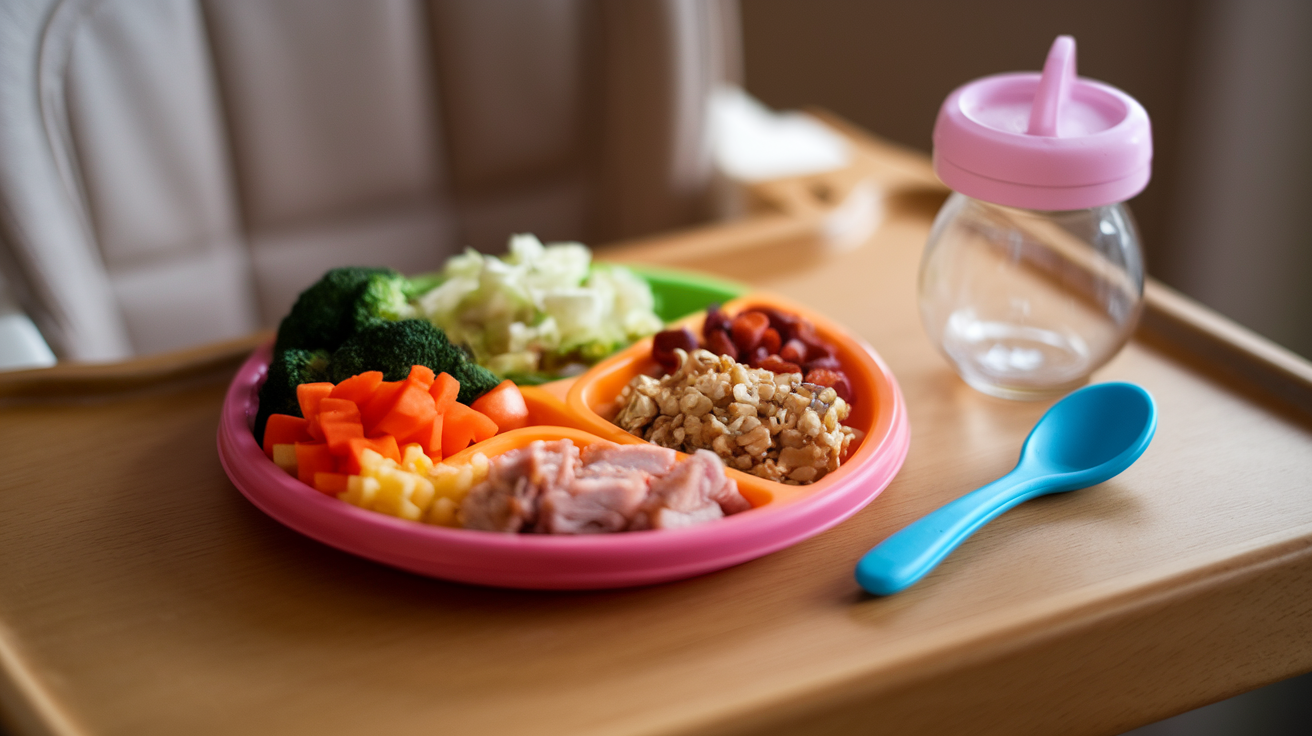As your little one reaches their first birthday, a whole new world of culinary adventures awaits! 🎉 But with this exciting milestone comes a crucial question: What should your 1-year-old be eating? The transition from baby food to “big kid” meals can be both thrilling and daunting for parents.
From soft fruits bursting with vitamins to protein-packed eggs and iron-rich beans, the range of nutritious options for your toddler is vast. But how do you ensure they’re getting all the essential nutrients they need for healthy growth and development? And what about those inevitable picky eating phases? 🤔
In this comprehensive guide, we’ll explore everything from the vital nutrients your one-year-old needs to smart strategies for introducing new foods. We’ll dive into the world of self-feeding, discuss the importance of hydration, and even share tips for creating balanced meal plans. Whether you’re a first-time parent or a seasoned pro, you’ll find valuable insights to help your little one thrive during this crucial stage of development.
Essential Nutrients for One-Year-Olds

A. Protein sources: lean meats, eggs, tofu
One-year-olds require adequate protein for proper growth and development. Lean meats, eggs, and tofu are excellent sources of protein for toddlers. These foods provide essential amino acids necessary for building and repairing tissues. Parents should offer a variety of protein sources to ensure a balanced diet.
| Protein Source | Benefits |
|---|---|
| Lean meats | Rich in iron and zinc |
| Eggs | Contain choline for brain development |
| Tofu | Plant-based protein, good for vegetarian diets |
B. Healthy fats: avocados, whole milk
Healthy fats are crucial for brain development and energy in one-year-olds. Avocados and whole milk are excellent sources of these beneficial fats. Whole milk, in particular, is recommended for toddlers as it provides essential nutrients and supports growth.
C. Fiber-rich foods: oatmeal, whole grain pancakes
Fiber is important for digestive health in toddlers. Oatmeal and whole grain pancakes are not only fiber-rich but also provide complex carbohydrates for sustained energy. These foods can be part of a balanced breakfast or snack for one-year-olds.
D. Vitamins and minerals: fruits, vegetables, dairy
A variety of fruits, vegetables, and dairy products ensure that one-year-olds receive essential vitamins and minerals. The MyPlate icon serves as a guide, emphasizing the importance of colorful vegetables and fruits in a toddler’s diet. Dairy products, preferably low-fat options, provide calcium and other nutrients crucial for bone development.
- Fruits: Offer a range of colorful options, limiting juice intake
- Vegetables: Include various colors to ensure diverse nutrient intake
- Dairy: Provide low-fat options for calcium and other essential nutrients
It’s important to note that portion sizes for toddlers should be about one-fourth of an adult’s serving. Parents should focus on offering nutrient-rich options while managing calorie intake through controlled portion sizes and non-processed foods.
Now that we have covered the essential nutrients for one-year-olds, we’ll explore the next important aspect of toddler feeding: transitioning to self-feeding. This stage is crucial for developing independence and motor skills in young children.
Transitioning to Self-Feeding

Now that we’ve covered the essential nutrients for one-year-olds, let’s explore the exciting journey of transitioning to self-feeding. This milestone typically begins around nine to twelve months when babies show interest in grasping food and bringing it to their mouths.
A. Introducing finger-friendly foods
To encourage self-feeding, start with soft, easily manageable foods that are safe for your baby to handle. Here are some suitable options:
- Soft fruits (ripe bananas, peaches)
- Steamed vegetables (carrots, broccoli florets)
- Whole grain pasta (small shapes)
- Diced proteins (soft-cooked chicken, tofu)
Remember to avoid choking hazards such as nuts, popcorn, and whole grapes.
B. Soft fruits for easy consumption
Soft fruits are excellent choices for early self-feeding:
| Fruit | Preparation | Benefits |
|---|---|---|
| Bananas | Peeled and cut into small chunks | Easy to grasp, rich in potassium |
| Peaches | Peeled and sliced | Soft texture, good source of vitamins |
| Ripe pears | Peeled and cut into small pieces | Easily mashable, provides fiber |
C. Steamed vegetables for nutrient retention
Steaming vegetables preserves nutrients while making them soft enough for your baby to eat:
- Carrots: Cut into small sticks
- Broccoli: Separate into small florets
- Sweet potatoes: Cut into soft cubes
D. Mashed beans and hummus for protein variety
Introducing mashed beans and hummus offers a nutritious protein alternative:
- Mash cooked beans (like kidney or black beans) for easy consumption
- Offer small amounts of hummus as a dip for soft vegetables
As you transition to self-feeding, be patient and expect some messiness. It’s a crucial developmental stage that enhances your child’s sensory experience with food. Remember to always monitor your baby during meals and differentiate between gagging (a normal reaction to new textures) and choking (which requires immediate attention).
With this foundation in self-feeding established, we’ll next explore the importance of hydration and dairy in your one-year-old’s diet, ensuring a well-rounded approach to their nutritional needs.
Hydration and Dairy

Now that we’ve covered transitioning to self-feeding, let’s dive into the crucial aspects of hydration and dairy for one-year-olds.
A. Importance of water intake
Water is essential for a child’s hydration, especially as they become more active. For children aged 6-12 months, the recommended daily water intake is 4-8 ounces, increasing with age. Proper hydration is critical, particularly during illness or hot weather.
Signs of dehydration to watch for include:
- Excessive sleepiness
- Sunken eyes and soft spots on the head
- Minimal or absent tears when crying
- Extreme irritability
- Dry mouth
- Fewer than six wet diapers a day
If you notice these signs, consult a pediatrician immediately. They may recommend an oral rehydration solution (ORS) to restore hydration and nutrients.
B. Benefits of whole milk and yogurt
At 12 months, whole milk becomes an important part of a child’s diet. It provides essential nutrients for healthy growth, including:
| Nutrient | Benefits |
|---|---|
| Calcium | Supports bone development |
| Vitamin D | Aids calcium absorption |
| Protein | Promotes muscle growth |
| Vitamin A | Supports eye health |
| Zinc | Boosts immune function |
Yogurt is another excellent dairy option, offering similar benefits to milk while also providing probiotics for gut health.
C. Calcium and protein from dairy products
Dairy products are crucial sources of calcium and protein for one-year-olds. The recommended milk intake for children 12-24 months is whole milk, transitioning to nonfat or low-fat milk for those 2 years and older.
It’s important to note that plant-based milks, except for soy milk, are generally not nutritionally equivalent to cow’s milk. If considering alternatives, consult with a pediatrician to ensure your child’s nutritional needs are met.
As we move forward to discuss food introduction strategies, remember that establishing healthy beverage habits early on can significantly influence a child’s future choices. Encouraging water and milk consumption while avoiding sweetened drinks helps set the foundation for lifelong healthy eating patterns.
Food Introduction Strategies

Now that we’ve covered the importance of hydration and dairy for one-year-olds, let’s explore effective strategies for introducing new foods to your little one’s diet.
A. Gradual introduction of new foods
Introducing new foods to your baby should be a gradual process. Start with small amounts, typically half a spoonful, and slowly increase as your baby becomes more comfortable. Here’s a helpful guide:
| Age | Food Consistency | Examples |
|---|---|---|
| 4-6 months | Pureed, single-ingredient | Iron-fortified cereals, pureed meats |
| 6-8 months | Mashed or finely chopped | Soft fruits, well-cooked vegetables |
| 8-12 months | Soft finger foods | Finely chopped fruits, soft meats |
Remember to wait 3 to 5 days between introducing new foods to monitor for any potential allergic reactions.
B. Multiple exposures for taste acceptance
It’s common for babies to refuse new foods initially. Here are some tips for encouraging acceptance:
- Offer the same food multiple times
- Mix new foods with familiar ones
- Make mealtime relaxed and engaging
- Allow babies to explore food through touch
C. Monitoring for potential allergic reactions
When introducing new foods, especially potential allergens, it’s crucial to be vigilant. Watch for signs such as:
- Skin rashes or hives
- Digestive issues (vomiting, diarrhea)
- Breathing difficulties
Always consult with your healthcare provider before introducing common allergens like eggs, peanuts, or fish.
As you progress through food introduction, remember that each baby develops at their own pace. Some may be ready for finger foods earlier, while others might need more time with purées. The key is to remain patient and consistent.
With these food introduction strategies in mind, we’ll next explore how to create balanced meal plans for your one-year-old, ensuring they receive all the essential nutrients for healthy growth and development.
Balanced Meal Planning

Now that we’ve covered strategies for introducing new foods to your toddler, let’s focus on how to create balanced meals that will provide optimal nutrition for your little one.
Combining different food groups
Creating balanced meals for your toddler involves incorporating a variety of food groups into each serving. A well-rounded meal should include:
- Fruits
- Vegetables
- Grains
- Protein
- Dairy
By offering a mix of these food groups, you ensure that your child receives a wide range of essential nutrients. For example, you might pair whole grain toast with scrambled eggs and sliced strawberries for a balanced breakfast.
Ensuring variety in textures and flavors
Introducing diverse textures and flavors is crucial for developing your toddler’s palate and encouraging healthy eating habits. Consider the following approaches:
- Offer a range of cooked and raw vegetables
- Include both soft and crunchy foods in meals
- Experiment with different cooking methods (steaming, roasting, grilling)
- Introduce mild spices and herbs to enhance flavors
Remember, it may take multiple exposures for your toddler to accept new tastes and textures. Be patient and continue offering a variety of foods.
Pairing foods for optimal nutrient absorption
Some nutrients work better together, enhancing absorption and overall nutritional value. Here’s a simple guide to food pairings that boost nutrient uptake:
| Nutrient Pair | Food Combination Examples |
|---|---|
| Iron + Vitamin C | Spinach salad with orange slices |
| Calcium + Vitamin D | Yogurt with vitamin D-fortified cereal |
| Healthy Fats + Fat-soluble Vitamins | Avocado slices with carrot sticks |
By thoughtfully combining foods, you can maximize the nutritional benefits of each meal.
When planning balanced meals for your toddler, keep in mind that appetites can fluctuate. It’s normal for toddlers to eat varying amounts from day to day. Focus on offering a variety of nutritious options and let your child’s hunger cues guide portion sizes.
To simplify meal planning, consider preparing freezer-friendly meals and creatively using leftovers. This approach not only saves time but also reduces food waste. Remember, while striving for nutritious meals is important, it’s okay to occasionally include less healthy options. The key is to maintain an overall balanced diet that supports your toddler’s growth and development.

Feeding a one-year-old is an exciting journey filled with nutritional milestones and new experiences. From essential nutrients to balanced meal planning, this guide has covered key aspects of toddler nutrition. By introducing a variety of soft, nutrient-rich foods like fruits, vegetables, lean proteins, and whole grains, parents can support their child’s growth and development while fostering healthy eating habits.
Remember that every child is unique, and it may take time for them to accept new tastes and textures. Be patient and persistent in offering a diverse range of foods, always prioritizing safety and monitoring for potential allergies. As your toddler transitions to self-feeding, embrace the messy but rewarding process of watching them explore and enjoy their meals. With a focus on balanced nutrition and gradual food introduction, you’re setting the foundation for a lifetime of healthy eating habits.

Leave a Reply